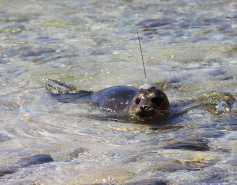
Best practice recommendations for the use of fully implanted telemetry devices in pinnipeds
- Telemetry
Abstract
Electronic telemetry devices have enabled many novel and important data collection and experimental opportunities for difficult to observe species. Externally attached devices have limited retention and may affect thermoregulation, energetics, social and reproductive behavior, visibility, predation risk and entanglement. Internally placed, surgically implanted devices can mitigate some of these effects and may open additional experimental opportunities. However, improper implementation can significantly affect animals and data. From a review of recent studies using fully implanted tags and studying their effects, we present 15 specific best practice recommendations for the use of such tags in pinnipeds. Recommendations address issues including device size, coating and sterilization, implantation surgery and effect assessment, within the framework of the Three R’s: Reduction, Refinement, Replacement. While developed for pinnipeds, these recommendations could apply to other aquatic mammals and vertebrates and to partially implanted or even external tags.
Horning, M., Haulena, M., Tuomi, P.A., Mellish, J.E., Goertz, C.E., Woodie, K., Berngartt, R.K., Johnson, S., Shuert, C.R., Walker, K.A., Skinner, J.P., Boveng, P.L. 2017. Best practice recommendations for the use of fully implanted telemetry devices in pinnipeds. Animal Biotelemetry (2017) 5:13.
Related Publications
{"image":"\/Animals\/Patients\/Harbor seals\/2013\/hs-agaptimoss-by-stan-jensen-c-the-marine-mammal-center.jpg","alt":"harbor seal with a satellite tag and antennae on its head","title":"Recommendations for the Use of Tracking Devices on Seals and Sea Lions","link_url":"https:\/\/www.marinemammalcenter.org\/publications\/recommendations-for-the-use-of-tracking-devices-on-seals-and-sea-lions","label":"Research Paper"}

{"image":"\/Animals\/Wild\/Gray whale\/cropped-images\/gray-whale-aerial-shutterstock-738-1090-2184-1706-1618526985.jpg","alt":"a gray whale mother and calf seen from above","title":"Observations of Tissue Healing Around an Implanted \u201cC\u201d Tag in a Gray Whale","link_url":"https:\/\/www.marinemammalcenter.org\/publications\/observations-of-tissue-healing-around-an-implanted-c-tag-in-a-gray-whale","label":"Research Paper"}

{"image":"\/Animals\/Patients\/Harbor seals\/2023\/cropped-images\/hs-turbo-by-bill-hunnewell-c-the-marine-mammal-center-2-214-3160-2468-1692045795.jpg","alt":"harbor seal pup in the water","title":"Harbor Seal Pup Dispersal and Individual Morphology, Hematology, and Contaminant Factors Affecting Survival","link_url":"https:\/\/www.marinemammalcenter.org\/publications\/harbor-seal-pup-dispersal-and-individual-morphology-hematology-and-contaminant-factors-affecting-survival","label":"Research Paper"}

Harbor Seal Pup Dispersal and Individual Morphology, Hematology, and Contaminant Factors Affecting Survival
Read More{"image":"\/Animals\/Wild\/Blue whale\/cropped-images\/blue-whale-aerial-shutterstock-2142-422-3258-2545-1717613306.jpg","alt":"blue whale seen from above","title":"Assessment of Wound Healing of Tagged Gray and Blue Whales Using Photographs","link_url":"https:\/\/www.marinemammalcenter.org\/publications\/assessment-of-wound-healing-of-tagged-gray-and-blue-whales-using-photographs","label":"Research Paper"}

Assessment of Wound Healing of Tagged Gray and Blue Whales Using Photographs
Read MoreRelated News
{"image":"\/Animals\/Patients\/Guadalupe fur seals\/2018\/cropped-images\/gfs-snaggle-by-cara-field-c-the-marine-mammal-center-noaa-permit-18786-376-0-3571-2789-1602455471.jpg","alt":"Guadalupe fur seal Snaggle","title":"Severe Entanglements Threaten Recovery of Guadalupe Fur Seals","link_url":"https:\/\/www.marinemammalcenter.org\/news\/severe-entanglements-threaten-recovery-of-guadalupe-fur-seals","label":"News Update","date":"2020-08-14 05:00:00"}

{"image":"\/Animals\/Patients\/Guadalupe fur seals\/2015\/cropped-images\/gfs-silkster-tag-by-dana-angus-c-the-marine-mammal-center-noaa-permit-18786-865-498-1357-1060-1604445254.jpg","alt":"Guadalupe fur seal Silkster is released with a satellite tag","title":"News Deeply: Tracking Elusive Seal Could Reveal Ocean Threats","link_url":"https:\/\/www.marinemammalcenter.org\/news\/news-deeply-tracking-elusive-seal-could-reveal-ocean-threats","label":"In the News","date":"2017-10-30 05:00:00"}

News Deeply: Tracking Elusive Seal Could Reveal Ocean Threats
October 30, 2017
Read More{"image":"\/Animals\/Patients\/Sea otters\/2017\/cropped-images\/so-yankee-doodle-photo-by-bill-hunnewell-c-the-marine-mammal-center-usfws-permit-ma101713-1-430-262-1660-1296-1604446578.jpg","alt":"sea otter Yankee Doodle eating shellfish","title":"KQED: In Bay Area, Even Sea Otters Have Wearable Med","link_url":"https:\/\/www.marinemammalcenter.org\/news\/kqed-in-bay-area-even-sea-otters-have-wearable-med","label":"In the News","date":"2017-09-13 05:00:00"}

{"image":"\/Animals\/Patients\/Guadalupe fur seals\/2015\/cropped-images\/gfs-photo-by-dana-angus-c-the-marine-mammal-center-noaa-permit-932-1905-01-20-4-1780-1391-1681501299.jpg","alt":"Guadalupe fur seal pup","title":"Guadalupe Fur Seals, a Threatened Species, Have Another Tough Year","link_url":"https:\/\/www.marinemammalcenter.org\/news\/guadalupe-fur-seals-a-threatened-species-have-another-tough-year","label":"News Update","date":"2016-11-10 01:00:00"}

Guadalupe Fur Seals, a Threatened Species, Have Another Tough Year
November 10, 2016
Read More